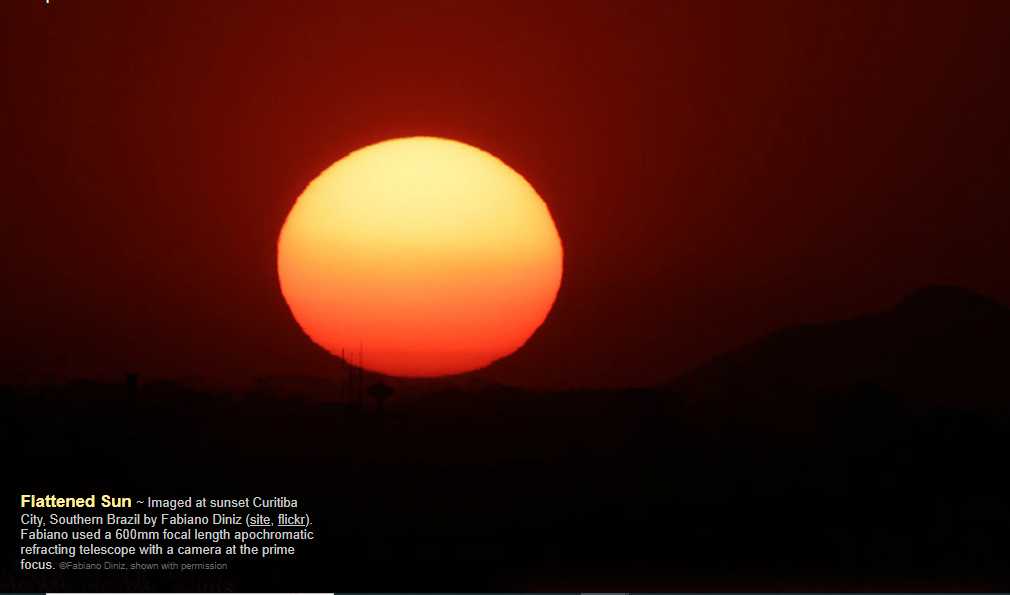OPOD - Flattened Sun
OPOD - Flattened Sun: A Closer Look at the Phenomenon
When we think of atmospheric optics, our minds often jump to the mesmerizing images of miraged suns and elusive green flashes. However, sometimes the serenity of an "ordinary" sunset can be equally captivating. Even in these moments, we can observe the visual evidence of Earth's dense atmosphere through the reddening and refraction of the sun's rays. What's particularly intriguing is that the sun's globe, despite its slow rotation, appears significantly flattened as it nears the horizon.
The flattening of the sun is not a result of the atmosphere's density alone. Rather, it stems from the density gradients within the atmosphere that thin out as we move farther away from Earth's surface. Rays of the setting sun, which are nearly parallel to the surface, undergo refraction and curve concavely towards Earth's center. This bending of light always occurs towards the denser medium, giving the illusion that the rays originate from a higher point in the sky. Consequently, the apparent position of the sun is raised.
The curvature of refracted rays causes another fascinating effect - the flattening of the sun's disk. As rays from the sun's lower limb pass through denser regions of the atmosphere with stronger density gradients, they experience more pronounced curvature. Consequently, the lower limb of the sun is raised to a greater extent than the upper limb, resulting in a flattened appearance.
The degree of flattening varies based on temperature and pressure conditions, leading to slight differences in the actual time of sunset and sunrise compared to almanac values. These effects are most pronounced in polar regions, where extreme refraction can cause phenomena like the Novaya Zemlya effect. In this rare occurrence, the sun may appear days before its expected first spring sunrise, bewildering observers with its early arrival.
It's not just from the Earth's surface that we can witness extreme refraction. High-flying aircraft and spacecraft also offer a unique perspective on this phenomenon. When the sun or moon's rays traverse the atmosphere twice before reaching the eye, the effects of refraction become even more apparent from these elevated vantage points.
The Flattened Sun phenomenon serves as a reminder of the intricate interplay between light and Earth's atmosphere. It showcases how the bending of light due to density gradients can alter our perception of celestial bodies and create captivating visual displays. By understanding the science behind this phenomenon, we gain a deeper appreciation for the wonders of our atmosphere and the stunning optics it can produce.
So, the next time you find yourself gazing at a sunset, take a moment to appreciate the subtle yet remarkable effects of refraction that give rise to the flattened appearance of the sun. It's a testament to the intricate beauty of our planet's atmosphere and its ability to continuously surprise and inspire us with its optical marvels.

Flattened Sun ~ Imaged at sunset Curitiba City, Southern Brazil by Fabiano Diniz (site, flickr). Fabiano used a 600mm focal length apochromatic refracting telescope with a camera at the prime focus. ©Fabiano Diniz, shown with permission

We see many pictures of miraged suns, sometimes with green flash finales, that the serenity of an 'ordinary' sunset can be welcome. Even then we have visual evidence of Earth�s dense atmosphere by its reddening and refraction. The sun�s globe - its slow rotation hardly alters its gravitational sphericity - is significantly flattened with the degree of flattening increasing towards the horizon.
The atmosphere�s density does not of itself lead to any refractive distortion. The distortion arises from the density gradients of an atmosphere thinning with increasing distance from Earth�s surface.
Rays of the setting sun almost parallel to Earth�s surface are refracted into a curve, concave towards Earth�s centre. Refracted rays always tend towards the denser medium. The result of the curvature is that - to the eye - the rays appear to come from a point higher in the sky. The apparent sun is raised. Rays from the sun�s lower limb pass deeper in the atmosphere and through stronger density gradients. They are more strongly curved and the lower limb is thus raised more than the upper making the disk appear flattened.
The extent of apparent raising depends on temperature and pressure and cause the actual time of sunset and sunrise to differ by minutes from the almanac value. These effects are greatest in polar regions giving rise in extremis to the Novaya Zemlya effect where the sun can appear days before its expected first spring sunrise.
Extreme refraction is also evident from high aircraft and spacecraft when the Sun or Moon�s rays traverse the atmosphere twice before reaching the eye.
Note: this article has been automatically converted from the old site and may not appear as intended. You can find the original article here.
Reference Atmospheric Optics
If you use any of the definitions, information, or data presented on Atmospheric Optics, please copy the link or reference below to properly credit us as the reference source. Thank you!
-
<a href="https://atoptics.co.uk/blog/opod-flattened-sun/">OPOD - Flattened Sun</a>
-
"OPOD - Flattened Sun". Atmospheric Optics. Accessed on December 24, 2024. https://atoptics.co.uk/blog/opod-flattened-sun/.
-
"OPOD - Flattened Sun". Atmospheric Optics, https://atoptics.co.uk/blog/opod-flattened-sun/. Accessed 24 December, 2024
-
OPOD - Flattened Sun. Atmospheric Optics. Retrieved from https://atoptics.co.uk/blog/opod-flattened-sun/.